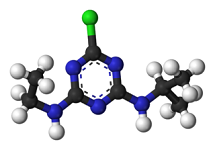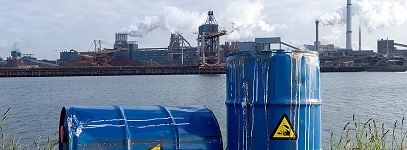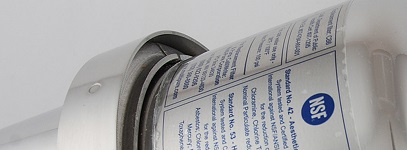
Health
Water2Drink Blog > HealthDown the DrainMonday, May 25, 2015 - Posted by Water2Drink, in Health, Water News, Products, Water Safety
The decision to purchase and use a water filtration system
is hopefully the beginning of consumer awareness of the quality of and care for
our fresh water sources. By the time a consumer makes that choice to invest in
their health, he or she has typically uncovered the poor quality of not only
their local water supply, but may have also uncovered larger, farther-reaching concerns
regarding the impact of purchasing choices on the global water supply. An article in this week’s New York Times online introduces us to Stiv Wilson, an
environmental advocate who has taken on the battle against microbeads.
Microbeads (or, #microplastics) are those miniscule colorful dots contained in toothpaste,
hand sanitizers, facial cleansers, and other cosmetic products. But once the
product is rinsed away, the beads rinse away with it and end up into our water
sources. “By the billions,” according to Rachel Abrams' article. “‘The effect is
similar to grinding up plastic water bottles, other products of concern to
environmentalists, and pumping them into oceans and lakes. But because
microbeads are small enough to be ingested by fish and other marine life, they
can carry other pollutants into the food chain.’”
While four states (IL, ME, NJ, and CO) have restricted the
use of #microbeads, there is no federal mandate at this time to restrict or ban
synthetic particles, or even to require the development and use of
biodegradable beads. But consumers can make responsible personal choices, deciding
not to purchase or use products that contain microbeads. “Consumers have more
outlets than ever to voice concerns about products, particularly online, where
a whisper of danger can turn into a roar. Seeing the effect on their sales,
manufacturers have increasingly faced pressure to respond to those concerns,”
says Ms. Abrams. The only way we can prevent this microscopic plastic pollution
in our waters is by insisting the products we buy are responsibly produced.
In the meantime, the use of a solid carbon block filter,
such as a Multipure Drinking Water System from #Water2Drink, will effectively remove these particles
from your drinking water. All Multipure systems are NSF tested and certified
to the submicron level, using both mechanical filtration and electrokinetic adsorption to
capture particulate matter. As the water passes through its densely compacted
#solidcarbon block filter, particles as small as 0.5 micron are removed. |
 0 Comments 0 CommentsTweet |
The Dirty DozenSaturday, April 25, 2015 - Posted by Water2Drink, in Health, Water News
Atrazine Molecule It’s human nature to discount or ignore issues that are not
right in front of us. You pay attention
to the bus that cut you off in traffic, but are you thinking about chemical disruptions
that may be happening in your body right now? Endocrine disruptors are hormone-altering chemicals that do
exactly as they say: they disrupt important bodily functions that are driven by
your #endocrine system. According to the Environmental Working Group’s (EWG)
website, endocrine disruptors can be responsible for “increasing production of
certain hormones; decreasing production of others; imitating hormones; turning
one hormone into another; interfering with hormone signaling; telling cells to
die prematurely; competing with essential nutrients; binding to essential
hormones; {and} accumulating in organs that produce hormones.”
Of the EWG’s “Dirty Dozen” #endocrinedisruptors, water-borne
contaminants are the easiest to avoid by using an NSF-tested and certified water
filter. All Multipure Drinking Water Systems are certified by NSF International to reduce the
greatest number of #contaminants, including many of those on the EWG’s Dirty
Dozen list. BPA, atrazine, lead, arsenic, mercury, fire retardants, and
pesticides are reduced by using a #Multipure Drinking Water System. |
 0 Comments 0 CommentsTweet |
All in the FamilyThursday, April 16, 2015 - Posted by Water2Drink, in Health, Water News
This week, we share this video of one family’s story about gaining
critical knowledge of their drinking water system, and understanding the
importance of knowing the effects of choices that a parent might make. This story hits close to home, as it is told
by Jennifer Rice, Executive Vice President of Multipure International, and the President
of Multipure’s Pure Foundation. The Pure
Foundation is a charitable organization dedicated to bringing clean drinking
water and better health to people without access to it.
Jennifer’s story about the health of her child highlights
the reason why we at #Water2Drink encourage you to contact us with any
questions you may have regarding the Multipure family of products. Each drinking water filtration system is
NSF-tested and certified, and each system offers different benefits for our
customers. By talking with you about
your personal #waterfiltration needs, Water2Drink.com will help you pinpoint
the most effective and economical drinking water system for your family. We can
explain how Multipure drinking water systems allow beneficial minerals to
remain in the water (excluding the Reverse Osmosis technology), while still
providing the greatest reduction of the most contaminants. We can also describe
how Multipure offers superior product performance when compared to others on
the market, and how the price you pay is reflected in the highest standards of
design, certification, and manufacture of your Multipure system. Our mission at Water2Drink.com is to present helpful information regarding the global water industry and to assist consumers in obtaining local, clean water. There are myriad of factors to consider when choosing the right drinking water filtration system for your health and the health of your loved ones. |
 0 Comments 0 CommentsTweet |
Spring CleaningFriday, April 3, 2015 - Posted by Water2Drink, in Health, Water News
{PD-US} Now that the weather has turned to spring over most of the
U.S., many people turn their minds to spring cleaning. There is something renewing about opening up
windows, letting in the fresh air and sunshine in, and clearing out your space
to make room for new, healthy opportunities. While you may focus on cleaning house, Water2Drink invites
you to consider the health of your body, organs, and tissues. Our bodies are more than 60 percent water,
the brain and muscles are 75%, bones are about 22%, and the blood is an
astounding 92% water. Keeping your organs in top working condition and
preventing toxic buildups in the body can be helped by a simple solution: drink
clean, filtered water with fresh lemon.
Drinking water with lemon has a variety of benefits. Staying hydrated is the most important, but
there are others equally as important. Lemons are an #alkaline food when
ingested (the citric acid does not create acidity in the body once it’s
metabolized). Water with lemon helps with weight loss, both because of its
alkaline properties and also because of lemon’s high pectin fiber content,
which helps fight cravings. The vitamin
C contained in lemon juice can boost your immune system, control blood
pressure, helps dissolve uric acid that often is related to joint #inflammation,
and cleanse toxins from the blood, which helps to clear the skin. Lemons are
also a good source of citric acid, potassium, calcium, magnesium, and
phosphorous.
It’s easy to add this simple tonic to your day. Simply start your day by drawing 8 to 12
ounces of filtered water and squeeze in the juice of half a lemon. It’s best to
drink this tonic when you first rise, at room temperature or warmed slightly
(warm the filtered water in a tea kettle or small saucepan, pour it into a cup,
and then add the lemon juice), as ice cold water may hinder the digestive
benefits. Drinking freshly filtered drinking water from your tap using a
Multipure Drinking Water System gives you convenient, clean, mineral-rich water
from your local water source. It also eliminates the need for expensive bottled
water and negates the impact of plastic bottles on the environment. |
 0 Comments 0 CommentsTweet |
How Exposed Are You?Friday, March 13, 2015 - Posted by Water2Drink, in Health, Water News
An interesting study came across the Water2Drink.com news desk
this week. It is the 2014 Silent Spring Institute’s “Scientists Identify
Highest Priority Toxic Chemicals to Target for Breast Cancer Prevention Study
Fact Sheet.” This fact sheet gives breast cancer prevention tips by “identifying
high-priority chemicals and evaluating tools to measure exposure” to suspected
carcinogens.
The measurement methods are called “exposure biomarkers.” They can be used to study cancer risk and
assist the public in reducing exposure to known or suspected toxins. Many chemicals, though, have never been
studied because there was no reliable way to measure exposure to carcinogens.
Scientists need to track exposures to toxins to determine where they come from
and to investigate if exposure reduction efforts make a difference.
The Silent Spring Institute study is easy to read and understand. The study “evaluated 102 common chemicals
that cause mammary tumors in laboratory studies of rodents.” Many of these chemicals are from gasoline and
the petroleum industries. More specifically, the study says “Drinking water can
contain mammary carcinogens, such as byproducts of disinfection or solvents
that are common well water contaminants.”
While the study provides implications for public health,
more importantly it contains a section that addresses how to reduce your
personal exposures (#SilentSpring Study, Page 5). And while this study focuses on #breastcancer,
the ways in which to reduce or eliminate the risks could apply to many #cancers.
There are many practical and easy steps, such as avoiding fuel and exhaust
(petroleum), using ventilation fans, and properly storing solvents and other
chemicals. The most significant suggestion is: “Use and maintain a solid carbon
block drinking water filter.”
The entire Multipure family of drinking water systems
feature a solid carbon block filter that is NSF-tested and certified to the
sub-micron level. A #Multipure Drinking
Water System does an amazing job of reducing chloramine, chlorine, disinfection by-products, and dozens of other contaminants, both naturally occurring
and man-made. |
 0 Comments 0 CommentsTweet |
Do You Know Your Neighbors?Friday, March 6, 2015 - Posted by Water2Drink, in Health, Water News, Water Safety
The March 5, 2015, issue of The Atlantic online magazine (theatlantic.com)
covers a consequential story about the Rice family outside of Asheville,
NC. Bob and Dot Rice bought a piece of
property in 1974, built a home there, raised children, and planned for the property
to be passed along to their two sons and their children. The home water source was a local spring a
few hundred yards behind the family cabin. According to the article, “after they moved in, the
Rices noticed the water coming out of the spring had a salty taste and smelled
musty.” They could smell a distinct #petroleum
smell coming from their well and spring, “especially when it rained. ‘I got
used to it,’ Terry Rice said. ‘We checked for bacteria. We didn’t check for
chemicals.’” In 1999, a family friend
discovered environmental contamination in the spring, along with barrels from a
long-closed factory that once bordered the property.
The contamination came from CTS Corporation, which operated a
factory plant that closed in 1986. The
company produced electronic components, and workers there used #TCE, a
colorless solvent with a sweet odor.
The article states, “Drinking or breathing high levels of TCE may cause
nervous system effects, liver and lung damage, abnormal heartbeat, coma, and
possibly death, according to the Agency for Toxic Substances and Disease Registry website. The EPA investigation found that CTS employees
were disposing of TCE and other chemicals by pouring them down the drains and
letting the chemicals leach into the ground.” A year after closing the factory, the company
sold the property to developers who had the soil at the site tested, but never had
the groundwater sampled or tested. Adding
insult to injury, the EPA “had a chance to clean up the site years ago but
didn’t. A memo from 1991 shows that federal regulators knew pollution from the
former factory threatened the surrounding community’s water and air. But the
agency failed to do more testing or even warn residents of potential dangers.”
This type of contamination can be an environmental nightmare. A wide range of chemicals can contaminate our
water, land, or air, which impacts our environment but also our health. Some pollutants resist breakdown and can
accumulate in the #foodchain, being absorbed by fish or wildlife, and then
eaten by residents. Contamination can
also impact coastal areas, waterways, surface water sources, and groundwater. It can be years or decades before the
contamination is identified, and even longer for the sites to be cleaned and
the water source becomes healthy again, if ever.
To combat environmental contamination, water consumers and
home buyers should educate themselves on the surrounding areas. What businesses
or industries are or were nearby? Were there #chemicals used in that industry? Has
there been environmental testing in the area? Even if your water source is
municipal (provided by your city or county), there are many opportunities for
water contamination to occur between a water treatment plant and your
home.
We at Water2Drink.com believe you have the power to protect
yourself and your family by using a water filtration device such as a Multipure
Drinking Water System. The family of #Multipure Drinking Water Systems are NSF-tested
and certified to reduce TCE and dozens of other chemical and organic contaminants,
including arsenic, metals and cysts. Each Multipure filter Owner’s Manual comes
with a Performance Data Sheet that outlines exactly what contaminants the
filters are certified to reduce, and to what degree. Most contaminants are reduced
more than 99 percent! |
 0 Comments 0 CommentsTweet |
Does Your Local School Serve Toxic Water?Thursday, February 19, 2015 - Posted by Water2Drink, in Health, Water News, Products, Water Safety
California has myriad water woes, and here’s another one to
consider. Seven years ago, the local
NBC4 I-Team investigated Los Angeles area schools that had children drinking
from potentially unsafe water fountains.
The schools had old fountains and pipes made with lead that leached into
the drinking water. Today, thousands of
schoolchildren in L.A. are still drinking from these fountains. The NBC4 story states the Los Angeles Unified School District
(#LAUSD) would solve the problem by having the water lines to each fountain
flushed daily, running the water for a minimum of 30 seconds at the beginning
of each school day. The schools were to
keep logs for proof that the lines were flushed. But a 2013 audit report says one #school was
found to have falsified the logs, and an additional six schools claimed they
had followed the policy but in fact hadn’t.
Lead leaching from older pipes and fixtures is a chronic
problem in older buildings like schools, and this problem can occur in any
school district in the country. The problem is exacerbated when communities use
chloramine to disinfect their water, which accelerates #lead leaching. Chloramine is a disinfectant that is
formed by mixing chlorine with ammonia.
It is a less effective disinfectant than chlorine, but is longer lasting
and stays in the water system as it is transported to the point of use.
The solution? Carry fresh, filtered water from home, using a
Multipure Drinking Water System from Water2Drink. The #Multipure family of drinking water
systems are all tested and certified to reduce #chloramine, along with dozens
of other contaminants, metals, PCBs, and cysts.
Using a Multipure system for your drinking water costs just $.09 cents a
gallon, and provides assurance that you are using a superior water filter in
removing or reducing the highest number of contaminants. Water2Drink.com is
happy to answer your questions about choosing the best #waterfilter for your
family’s needs. |
 0 Comments 0 CommentsTweet |
What Are Your Drinking Water Standards?Friday, February 13, 2015 - Posted by Water2Drink, in Health, Water News, Water Safety
If your community water system violates drinking water
standards, do you trust them when they say “there is nothing you need to do?” Recently, the town of Wrightsville Beach, NC, experienced a
violation of the drinking water standard for #trihalomethanes. While the public notice indicates this is not
an emergency, it goes on to list the possible health risks associated with the
liver, kidneys, and central nervous system, including #cancer.
The town is working with the NC Department of Environment
and Natural Resources (NCDENR) to bring the contaminant concentration down and
into compliance, and that they “anticipate improvements within three months.” The
notice also says the public doesn’t need to boil water or take other corrective
actions. But during that three-month
period, and for potentially longer, the public is still exposed to
trihalomethanes in their drinking water.
If this happened to your water supply, are you willing to risk your
health for three months?
The only way to ensure your health and the safety of your
drinking water is to be proactive. Using
a Multipure Drinking Water System allows you to be in control of the quality of
your water source. The Multipure family
of filtration products are NSF-certified to reduce trihalomethanes, the
offending contaminant, along with dozens of other #contaminants, cysts, and
heavy metals.
Water2Drink believes the consumer should know exactly what
contaminants are reduced by using a #Multipure product. On our website, Water2Drink.com, we have
provided links on each product page to the description, features,
documentation, specifications, and “What’s in the Box.” Simply click on the Products link on our
homepage, then click the drinking water system you are researching. You will find the Performance Data Sheet
listed under the “Documentation” tab.
You can’t always trust the water source, but you can trust your
Multipure Drinking Water System.
|
 0 Comments 0 CommentsTweet |
Your Pet: Merely a Companion, or a Member of the Family?Saturday, January 31, 2015 - Posted by Water2Drink, in Health, Water Safety
For many of us, our pets are not just a companion to us. Pet owners often consider their pets to be an
actual family member. Whether
four-legged and #furry, or two-legged and feathery, we want to give our family pets
the very best lives we can. Pet industry expenditures have skyrocketed more than 200% in
the past 20 years. Pet owners spare no expense on nutritious food, high quality #veterinary care, holiday presents, and necessary pharmaceuticals or
surgeries. We devote ourselves to
ensuring our pets have a quality of life at least as high as our children or
other family members.
When providing for the health, safety and comfort of your
pet, have you considered the quality of water you are providing? Using water from the tap or from a garden
hose can expose your #pets to contaminants that pose a threat to their health. These can include arsenic, cysts, lead, PCBs,
and radon. Tap water may be treated in
your community, but your pet will ingest the chemicals used in the water
treatment process, such as chlorine and chloramine. Filling up their outdoor water bowl from the
garden hose poses an entirely new level of contamination, as garden hoses can
contain hazardous chemicals and metals such as parasites, lead, cadmium,
bromine, and bisphenol A. Also, keep in mind that unlike residential fixtures, #gardenhoses
and fittings are not regulated under the Safe Water Drinking Act. |
 1 Comments 1 CommentsTweet |
The Next Generation: Teaching Our Children About Water ResourcesWednesday, January 21, 2015 - Posted by Water2Drink, in Health
As adults, we are able to easily find information about water
resources, water efficiency and #conservation.
Why not set an example for our next generation, who will be directly impacted
by our choices today? Children are naturally curious about the world around them.
They are thirsty for knowledge, and they also exhibit compassion for issues
that affect them. Bringing water
efficiency and conservation to their attention at a young age can allow them to
learn and take ownership of this important resource. The Environmental Protection Agency has
created “Water Sense Kids,” an easily approachable learning tool. It provides simple examples and promotes
water conservation. It also has a link
specifically for educators, which provides program materials to be used
alongside the “Water Sense” information.
Water2Drink.com believes the key to a good life is having
great #health. We believe good healthy
habits begin in childhood, and drinking plenty of clean, delicious water is a
habit that can be easily created in children.
Once your #children are treated to healthful #water, they will most likely
choose Multipure-filtered water over other beverages. |
 0 Comments 0 CommentsTweet |
Raising Awareness of AsbestosMonday, January 5, 2015 - Posted by Water2Drink, in Health, Water Safety
Most Americans know the dangers of asbestos, a naturally occurring
mineral. Asbestos was heavily used from the
1930’s to the 1970’s as insulation on water or steam pipes, and in floor, ceiling and
siding tiles, textured paint and soundproofing materials. Many people believe asbestos was banned from
use in the 1970’s, but a complete ban was decided against by the U.S. #Congress, allowing
numerous asbestos-containing products to remain on the market. Some of these include construction materials,
automotive products such as gaskets and brake pads, and asbestos clothing such
as gloves and welder’s blankets.
If you suspect your home contains asbestos, don’t
panic. Older homes often do contain it,
but if the material is in good condition and not deteriorating, the best
solution is to leave it alone. Material
that is crumbling, or if it has been scraped or sanded, is more likely to
create a health hazard. However, even if
your home does not contain #asbestos, it is possible that because asbestos is
still in our environment, you are at risk for exposure.
A recent blog post by Adam Lee, who writes for The #Mesothelioma
Center, describes how asbestos can be found in our tap water via its use in the
cement pipes of water distribution systems around the country. The U.S. Environmental Protection Agency
(EPA) screens for and regulates the levels of acceptable contaminant levels,
and in 1992 the EPA added asbestos to the list of #contaminants often found in
tap water.
Of course the only way to know you are not ingesting asbestos
is to filter your drinking water, using a high-quality filter that specifically
addresses asbestos as a contaminant. The
Multipure family of water filters are all tested and certified by NSF
International, the independent third party that is widely recognized around the
world for its expertise in testing and certifying consumer goods for health and
safety. All Multipure Drinking Water
Systems are NSF certified to reduce asbestos. |
 1 Comments 1 CommentsTweet |
Is It Safe to Drink the Water?Friday, December 19, 2014 - Posted by Water2Drink, in Health, Water News
If you are living in the United States, you probably have
never had to ask that question in any restaurant, private home, or business
setting. Most Americans believe that the
water pouring from their faucets is a reliable source of safe drinking water. Almost
no American has ever had to ask, is it safe to drink the water? Clean, safe public drinking water was not always so
available. Public water systems began to be established in the 1800’s, yet the
first standards for drinking water were not developed until 1914, and even then
the standards only applied to interstate common carriers such as trains, buses,
and ships. A comprehensive article by Professor
James Salzman and published by Slate.com states, “In historic terms, the
assumption of safe drinking water is a very recent development.” What we now
consider safe, uniform drinking water
standards weren’t actually put into place until the Clean Water Act of 1972,
and with the passage of the Safe Drinking Water Act (SDWA) of 1974.
However, while these measures certainly deserve recognition,
there are still significant challenges ahead for public drinking water delivery
systems. The Environmental Protection Agency has estimated $384 billion in
infrastructure needs ahead to replace aging water mains, which date back to the
1860’s. The SDWA is also faced with “emerging contaminants,” by-products of our
modern lifestyle. Newly recognized contaminants from medications, personal care
products, and components that act like hormones were unimaginable when our
water treatment systems were designed.
Even new contaminants introduced by hydraulic #fracking have not yet been
addressed. Therefore, these polluted fluids and #contaminants are not now being addressed
by municipal treatment plants.
These infrastructure changes will take incredible amounts of
effort, time and money. Don’t wait for
the public infrastructure to “catch up” to what is happening today. Get ahead
of these potential health hazards and filter your own water at the point of use. #Water2Drink recommends industry-leader Multipure
International as the high-quality, reasonable-cost manufacturer. As these newly emerging contaminants affect
our water supply, Multipure is constantly pursuing improvements to their solid
carbon block filter to address these concerns. Water2Drink.com is here to help
you decide which filter will provide the protection you need. |
 0 Comments 0 CommentsTweet |
Is Your Filtered Water Cloudy?Friday, November 21, 2014 - Posted by Water2Drink, in Health, Water News, Products, Water Safety
It’s that time of year again, when the snow is blowing, the
wind is howling, and your water is… cloudy? Probably the single most asked question we get in the wintertime
from our customers is, “Why is my filtered water cloudy?” Water can be cloudy for two reasons, one that
is benign and one that can be very bad.
The benign answer is:
it’s just air. If you are using a
high quality point-of-use water filter, such as a Multipure Drinking Water
System, you may be surprised to see cloudy or milky-looking water coming from your
filter. This most often occurs when the
water is cold (coming from cold ground water or being transported underground
through cold pipes). One of the
properties of water is its ability to dissolve gasses, including #air. Cold water is denser than warm water, and
therefore it is capable of holding more dissolved gasses. The cloudiness or milkiness is simply
dissolved air. You can test this by
filtering a glass of water and letting it set on the counter for a moment or
two. The cloudiness (air) will dissipate upwards from the bottom of the glass,
leaving a glass of clear filtered water.
Why is this not considered turbidity? Turbidity is the measure of relative clarity
of a liquid, or of how much material may be suspended in water and how that
material decreases the passage of light through the water. Turbidity refers to how clear water is, and
indicates the presence of total suspended solids. When solids are present in water, this
indicates the water is not clear of particulate matter, and these solids may
also be contaminants of great health concern. An article on Waterontheweb.org states, “turbidity
adds real costs to the treatment of surface water supplies used for drinking
water since the #turbidity must be virtually eliminated for effective
disinfection (usually by chlorine in a variety of forms) to occur. Particulates may also provide attachment
sites for heavy metals such as cadmium, mercury and lead, and many toxic
organic contaminants such as PCBs, PAHs and many pesticides.”
Of course, you must use a quality water filtration system such
as a #Multipure filter to remove particulates and contaminants. But just how does this filtration work? For contaminants having a physical size, the solid
carbon block filter provides mechanical filtration on a submicron level to
remove particulates and bad tastes. It
also employs electrokinetic adsorption to attract and control charged particles. Almost any carbon filter can reduce chlorine
and address taste and odor problems. The
Multipure solid carbon block technology goes well beyond aesthetic improvements
to remove the broadest array of #contaminants, including turbidity. Each product in the Multipure family is
provided with a Performance Data Sheet that details NSF’s product certification
data and contaminant reduction test results.
|
 5 Comments 5 CommentsTweet |
Should I Be Drinking Coconut Water?Friday, November 7, 2014 - Posted by Water2Drink, in Health, Water News
You can’t pick up a fitness magazine or read an online
article that doesn’t tout the benefits of coconut water. Even non-athletes buy into the claim that #coconutwater is full of electrolytes, potassium and other nutritional
benefits. But is it all just marketing? A recent article from Time.com asked the
experts, and four out of five agreed that there are other factors to
consider. Coconut water can have as much
sugar as a banana, even an unsweetened version, but have none of the beneficial
fiber.
Fluid loss during strenuous exercise is common, and can
result in stress, impaired cognition and cardiovascular function, increased
fatigue, and impaired #exercise performance. Following the recommendations for
fluid intake before, during, and after exercise is particularly important. But unless you are an elite #athlete,
carbohydrate/electrolyte sports drinks are not necessarily the beverage to
choose for rehydration. A 2012 study
funded by a coconut water manufacturer (Vita Coco) found little difference in
hydration after a workout by drinking water, coconut water, or a sports drink. On page 7 of the study, under “Results:
Performance Data,” the study concludes that “no significant difference… was
noted in total exercise time between bottled water… coconut water from
concentrate… and sport drink… .”
Fresh, clean water is the most suggested fluid for general
fitness enthusiasts. If you don’t want
to pay for expensive, exotic water from a coconut, we recommend a Multipure
water filtration system. Water2Drink.com
offers the entire #Multipure family of products, from the Aquamini travel
version, to the AquaRO, a full reverse osmosis system, and everything in
between, including the Aquaperform which reduces #arsenic as well. For just 9 cents a gallon, you can have
fresh, filtered water at your fingertips for post workout hydration, food
preparation, and ice. |
 0 Comments 0 CommentsTweet |
Transmittable Viruses and PathogensFriday, October 17, 2014 - Posted by Water2Drink, in Health, Water Safety
Cryptosporidium It’s impossible to ignore the news about the first-ever emergence
of the Ebola virus here in the United States.
Citizens are quite concerned with the potential to be infected with this
rare and deadly virus. While #Ebola is certainly a grave illness, at this time it is
unlikely that the majority of people in the U.S. will come into contact with
the virus. However, there are numerous
other non-viral, waterborne parasites that can infect all citizens, even within
a treated municipal water delivery system.
For example, the Cryptosporidium
pathogen can cause the diarrheal illness cryptosporidiosis. Cryptosporidium is not passed along by
insects, but is transmitted by hardy cysts that can be ingested and that result
in gastrointestinal infection and illness.
Cryptosporidium can survive
for long periods outside a host, and is resistant to common disinfectants
including chlorine-based disinfectants.
High concentrations of chlorine disinfection is required to inactivate #Cryptosporidium. Generally, the required levels of chlorine
preclude the use of this #disinfection method as a reliable method to control it
in drinking water.
Other microbial pathogens (microorganisms capable of causing
disease) such as Giardia, Entamoeba, and Toxoplasma can be transmitted by fecal
contamination of surface waters used as drinking water sources, or by other
exposures such as touching contaminated soil or eating unwashed fruits and
vegetables.
The good news is you can easily protect yourself. All #Multipure Water Filtration Systems have
been NSF tested and certified for 99.95 and over reduction percentage levels of
these waterborne microbial cysts. In
addition, a Multipure system will also reduce the chlorine-based disinfectants
that are used by municipal water treatment plants. You can check the reduction
levels of all contaminants on our Water2Drink website.
The Product Page for each water filtration system contains a link to the Performance Data Sheet which
contains that information. Use your
Multipure filtered water for drinking, washing foods, ice cubes, boiling
foods, or for any ingestible use. |
 0 Comments 0 CommentsTweet |
Are You Exposed to PCE?Friday, October 10, 2014 - Posted by Water2Drink, in Health, Water News, Water Safety
A recent article in The
Washington Post brings to light a new example of neurotoxin exposure in the
environment. Tetrachloroethylene, or PCE, was used by New England’s water
utilities to line the insides of water pipes in the late 1960’s. PCE has been linked to increased risk for
stillbirths and other pregnancy complications. PCE is widely used in the
dry cleaning industry also, so it may be of concern for many other citizens as
well. The toxin has been linked to
mental illness, breast cancer risks, and some birth defects.
Unfortunately, PCE was not only found in the New England
area. Contamination has been found on military
bases across the country as well, along with water systems in Pennsylvania and
California.
There is a simple solution to address this problem: use a Multipure Drinking Water System at your
sink or point-of-use water supply to filter your drinking water. Multipure filters are NSF tested and
certified under NSF/ANSI Standard 53 Health Effects to reduce the widest array
of water contaminants of health concern of any filter on the market, including
PCE. You can find a confirming Performance Data Sheet on our Water2Drink website that will
give you the list of all contaminants that are addressed by using a Multipure
water filter.
If you would like to learn more about PCE, the Environmental
Protection Agency has information on their website as well. Click here for more information about health
effects and the EPA’s drinking water regulations.
|
 1 Comments 1 CommentsTweet |
The (Water) Fountain of YouthFriday, October 3, 2014 - Posted by Water2Drink, in Health, Water News
Your search for the elusive Fountain of Youth could be as
close as your kitchen sink. Water is a critical life element for our body. Our organs cannot function properly when the
body is not adequately hydrated, because water is taken from other places
within the body to combat dehydration. This can lead to sunken skin, increased
acne, and weakened muscles and joints.
A recent article on modernsalon.com includes a case study in
which the Daily Mail U.K. writer Sarah Smith asks, “What would happen if I
drank the recommended amount every day for a month?” The article includes a before and after
picture of Ms. Smith, who concluded she looked 10 years older in her before
picture. Dark under-eye shadows, blotches, and lackluster skin all disappeared
in just 30 days.
Are you looking for a healthy, easy way to look younger? What
would you be willing to do to take 10 years off your face? How about nourishing
your body with fresh, clean drinking water? We can help to provide the water if
you are willing to take the challenge. A Multipure water filtration system will
give you the healthy water you need for your challenge. The rest is up to you! Just drink the recommended 8 to 10 glasses of
water each day and see what happens. |
 0 Comments 0 CommentsTweet |
What Are You Made Of?Friday, August 29, 2014 - Posted by Water2Drink, in Health
We hear all the time about how much water a person should
drink. But have you ever wondered what
would happen if you stopped drinking water?
The creators of AsapScience, Mitchell Moffit and Gregory
Brown, have weekly videos that help to understand the science of your own
life. Their “Weekly Dose of Science”
video called "What If You Stopped Drinking Water" explains how we would begin
to feel as the effects of dehydration take over our bodies. “Much like the desire to breath oxygen, thirst is a survival
instinct,” according to the AsapScience video.
With H2O being the most abundant molecule in our bodies, it performs important
functions such as carrying nutrients and hormones, regulating body temperature,
cushioning our joints and providing lubrication. These functions produce about 1.5 liters of
urine a day, which is essential for the body to replace before it begins
shutting down.
While the body can exist many days without food, within one
to two days of no fluids the effects of dehydration can seriously impact the
body. Within three to five days, our
organs and brain shut down.
The body needs water.
It is possible to replace fluids with any substance containing water,
such as soda, tea, or even some foods; however, clean water is the essential
element that the body can best assimilate, as our bodies are made up of about
65 percent water.
While NASA is figuring out how to turn urine into clean
drinking water, you may want to just filter your home tap water. Multipure makes a water filter for almost
every environment, and we here at Water2Drink.com are able to help you determine
which one is right for you. |
 0 Comments 0 CommentsTweet |
The Heat Is On!Monday, June 30, 2014 - Posted by Water2Drink, in Health, Water News
Now that we
are in the heat of summer, many people think that consuming sports or energy drinks
will provide replacement electrolytes and nutrients lost through sweating or
sports activities. In fact, these drinks
are extremely high in sugar and are particularly marketed within sporting
events. For example, among sponsors of
the World Cup currently being held in #Brazil, Coca Cola is an official
corporate partner of #FIFA, and McDonald’s is an official sponsor of the #WorldCup. Marketing messaging
gives the impression that these drinks, though high in sugar, could support an
active, healthy lifestyle. As with other
health products, you should educate yourself on the content of these drinks,
and the effect sugar consumption has on the body. Some of the energy drinks contain between 60
and 70 grams of #sugar in a single bottle.
Additionally,
research shows that liquid calories are known to be less satiating than solid
calories and fill you up less. This can
set up a cycle of overindulging on sugary beverages as the body searches for
nutrients and hydration.
Unless you
are an elite athlete, the best hydrating beverage for the body is fresh,
filtered water. Replacing sugary drinks
with water reduces your sugar intake and cuts your risk of obesity, high blood
pressure and diabetes. Consider the
critical role water plays in your body, and find out here how much water your
body needs for digestion, body temperature regulation, and other important
functions. |
 0 Comments 0 CommentsTweet |
Drink Water for Life!Friday, June 20, 2014 - Posted by Water2Drink, in Health, Water News
Do
you realize just how important drinking water is to the efficient functioning
of a healthy human body? It is estimated that your body consists of 60% to 75%
water. So much of your health and how you feel is related to the quality and
quantity of water you consume. Listen to Deanna DeLong, a self-proclaimed
“water advocate,” present the “Drink Water For Life” story in a highly
informative YouTube video that outlines the virtues of drinking enough
water.
You
can view the video by clicking on this link: www.youtube.com/watch?v=833lbjUejFM
|
 1 Comments 1 CommentsTweet |


